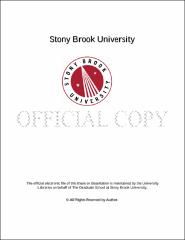| dc.identifier.uri | http://hdl.handle.net/11401/76446 | |
| dc.description.sponsorship | This work is sponsored by the Stony Brook University Graduate School in compliance with the requirements for completion of degree. | en_US |
| dc.format | Monograph | |
| dc.format.medium | Electronic Resource | en_US |
| dc.language.iso | en_US | |
| dc.publisher | The Graduate School, Stony Brook University: Stony Brook, NY. | |
| dc.type | Thesis | |
| dcterms.abstract | Surface texturing in micro/nanoscale plays an important role in many application fields including enhanced light trapping in solar cell, self-cleaning and anti-icing surfaces by achieving super-hydrophobicity in wind turbine and airplane wings, and enhanced convective and radiative heat transfer from surface. For metals such as copper and stainless steel which have been widely used in modern industries, formation of super-hydrophobic surfaces can offer significant benefits in terms of reliable and efficient operation by enabling, for instance, surfaces free from corrosion, contamination, freezing, and crack with improved heat dissipation. Super-hydrophobic surface is a highly hydrophobic surface typically with water contact angle exceeding 150° and roll off angle or hysteresis smaller than 10°, which is also known as Lotus Effect®. Formation of super-hydrophobic surface has been an area of very active research, typically falling into two representative categories: inducing physical roughness in micro/nanoscale, and modification of surface energy by coating method, which are frequently mixed in most practical applications. Laser structuring on the metallic surfaces has been examined to generate surface roughness in micro, even nanoscale to form super-hydrophobic surface utilizing the very limited heat affected zone by ultrashort pulses yet mainly with extra surface chemical treatment or coating to reduce surface energy. This study will demonstrate high flexibility and control precision offered by the efficient and economic pulsed laser scanning method. Compared with conventional laser-based approach, nanosecond laser scanning method tested corresponds to a highly cost-effective and uniform means for the texturing of arbitrary sample area with excellent precision. Nanosecond pulsed lasers are employed to scan over the copper, stainless steel and aluminum surfaces for micro/nano patterning and thereby formation of hierarchical structures towards high water repellence (Super-hydrophobicity) and stabilization. Achievement of super-hydrophobic surfaces involves complex surface oxidation mechanisms. For copper, CuO was formed during laser irradiation and deoxidized to Cu2O which is key to super-hydrophobic phenomenon. For stainless steel, it is believed that carbon is involved with the surface wettability shift. Relevant texturing mechanisms are explained based on advanced characterization by scanning electron microscope (SEM) and surface chemical composition analysis using Energy Dispersive X-ray Spectroscopy (EDS). Static contact angle and dynamic contact (i.e. hysteresis) indicating water wettability and surface homogeneity were also observed and analyzed by contact angle measurement. | |
| dcterms.abstract | Surface texturing in micro/nanoscale plays an important role in many application fields including enhanced light trapping in solar cell, self-cleaning and anti-icing surfaces by achieving super-hydrophobicity in wind turbine and airplane wings, and enhanced convective and radiative heat transfer from surface. For metals such as copper and stainless steel which have been widely used in modern industries, formation of super-hydrophobic surfaces can offer significant benefits in terms of reliable and efficient operation by enabling, for instance, surfaces free from corrosion, contamination, freezing, and crack with improved heat dissipation. Super-hydrophobic surface is a highly hydrophobic surface typically with water contact angle exceeding 150° and roll off angle or hysteresis smaller than 10°, which is also known as Lotus Effect®. Formation of super-hydrophobic surface has been an area of very active research, typically falling into two representative categories: inducing physical roughness in micro/nanoscale, and modification of surface energy by coating method, which are frequently mixed in most practical applications. Laser structuring on the metallic surfaces has been examined to generate surface roughness in micro, even nanoscale to form super-hydrophobic surface utilizing the very limited heat affected zone by ultrashort pulses yet mainly with extra surface chemical treatment or coating to reduce surface energy. This study will demonstrate high flexibility and control precision offered by the efficient and economic pulsed laser scanning method. Compared with conventional laser-based approach, nanosecond laser scanning method tested corresponds to a highly cost-effective and uniform means for the texturing of arbitrary sample area with excellent precision. Nanosecond pulsed lasers are employed to scan over the copper, stainless steel and aluminum surfaces for micro/nano patterning and thereby formation of hierarchical structures towards high water repellence (Super-hydrophobicity) and stabilization. Achievement of super-hydrophobic surfaces involves complex surface oxidation mechanisms. For copper, CuO was formed during laser irradiation and deoxidized to Cu2O which is key to super-hydrophobic phenomenon. For stainless steel, it is believed that carbon is involved with the surface wettability shift. Relevant texturing mechanisms are explained based on advanced characterization by scanning electron microscope (SEM) and surface chemical composition analysis using Energy Dispersive X-ray Spectroscopy (EDS). Static contact angle and dynamic contact (i.e. hysteresis) indicating water wettability and surface homogeneity were also observed and analyzed by contact angle measurement. | |
| dcterms.available | 2017-09-20T16:50:17Z | |
| dcterms.contributor | Colosqui, Carlos. | en_US |
| dcterms.contributor | Hwang, David | en_US |
| dcterms.contributor | Longtin, Jon | en_US |
| dcterms.creator | Liu, Di | |
| dcterms.dateAccepted | 2017-09-20T16:50:17Z | |
| dcterms.dateSubmitted | 2017-09-20T16:50:17Z | |
| dcterms.description | Department of Mechanical Engineering. | en_US |
| dcterms.extent | 88 pg. | en_US |
| dcterms.format | Monograph | |
| dcterms.format | Application/PDF | en_US |
| dcterms.identifier | http://hdl.handle.net/11401/76446 | |
| dcterms.issued | 2013-12-01 | |
| dcterms.language | en_US | |
| dcterms.provenance | Made available in DSpace on 2017-09-20T16:50:17Z (GMT). No. of bitstreams: 1
Liu_grad.sunysb_0771M_11687.pdf: 6677518 bytes, checksum: eae4df503f1e7465b52925ee62f819a0 (MD5)
Previous issue date: 1 | en |
| dcterms.publisher | The Graduate School, Stony Brook University: Stony Brook, NY. | |
| dcterms.subject | Mechanical engineering | |
| dcterms.subject | laser process, metallic surface, nanosecond pulsed laser, self-cleaning, super-hydrophobicity | |
| dcterms.title | Super-hydrophobic metallic surface formation by short pulsed lasers | |
| dcterms.type | Thesis | |

